Malpractice in vocational and technical qualifications: academic year 2017 to 2018
Published 24 August 2021
Applies to England
This report presents an analysis of penalties issued by awarding organisations for malpractice in higher stakes Vocational and Technical Qualifications (VTQs). This includes all VTQ Performance Table Qualifications (PTQs), Functional Skills Qualifications (FSQs) and Other General qualifications. The data covered in this report was collected from the relevant awarding organisations and focuses on the 2019 to 2020 academic year. Data was requested from 40 awarding organisations, covering 1,174 qualifications, although penalties were not reported for all of these. Comparisons between the 2019 to 2020 and previous academic years are not provided. This is because of the exceptional nature of assessments taken in summer 2020 due to the coronavirus (COVID-19) pandemic which means that comparisons are not valid.
The analyses focus on the types of offences committed by, and the types of penalties issued to, students, centres, centre staff and examiners in England.
Main Findings
- A total of 1,381 penalties were reported for the academic year 2019 to 2020, for student, staff and centre offences. To give some context, there were just over 1 million certificates issued in 2019 to 2020 for the types of qualifications listed above, so the number of penalties is small.
- The highest number of these penalties were issued to students (78%), followed by centre staff (13%), and centres (9%). No penalties for examiners were reported.
- The majority of malpractice cases resulted in a single penalty.
- In 2019 to 2020, 973 penalties were issued for PTQs, 346 for FSQs, and 45 for Other General qualifications (and 17 for cases which were not specific to any qualification).
- In 2019 to 2020, the number of penalties was greater for external assessments[footnote 1] (67%) compared to internal assessments (33%).
- The number of penalties was highest in paper-based exams (73%), followed by online exams (19%) and lastly, performance-based tasks[footnote 2] (7%). The number of penalties for external assessments was highest in timetabled assessments (36%), followed by on-demand (non-sessional) assessments (27%) and on-demand (sessional) assessments (4%). The remaining 467 penalties (34% of penalties) were either internal assessments, or the assessment schedule was unknown.
- The most common type of malpractice for students in 2019 to 2020 was ‘plagiarism’ (35% of student penalties). The large proportion of malpractice in the form of ‘plagiarism’ likely reflects the high proportion of internal, coursework-based, assessments in VTQs.
- For centres and centre staff, ‘maladministration’ was the most common type of malpractice offence, responsible for 58% of centre malpractice and 38% of centre staff malpractice.
- The most common type of penalty issued to students was a ‘warning’ (41% of student penalties), followed by a ‘loss of marks’ (36% of student penalties).
- For centre staff, the most common types of penalties issued were ‘written warning’ and ‘training’ (both accounting for 40% of centre staff penalties).
- For centres, the most common types of penalties used were ‘withdrawal of approval for a specific qualification’ and ‘written warning’ (38% and 22% of centre penalties respectively).
Introduction
Malpractice is a serious threat to the safe delivery of, and trust in, qualifications. It undermines the integrity of assessments. It includes attempts by students to plagiarise, and attempts by school or college staff to give too much support (meaning, improper assistance). Ofqual requires awarding organisations to have procedures in place to prevent, investigate and act in relation to malpractice incidents.
It is important for Ofqual, as the regulator of qualifications, examinations and assessments in England, to have a good understanding of the scale and nature of malpractice and the ways in which malpractice is identified, mitigated and sanctioned.
While we routinely collect malpractice data for GCSE and A levels, we have had less routine data on malpractice in Vocational and Technical Qualifications (VTQs) in previous years. Ofqual decided to collect data for the first time in 2019 on some of these qualifications to give equal visibility to malpractice in VTQs. The findings were published in July 2020 in the publication: Malpractice in vocational and technical qualifications: academic year 2017 to 2018.
The qualifications covered in this report are VTQs that were included in the Department for Education’s (DfE) performance tables in their respective years. This covers all PTQs except for: GCSE, AS, A Level, the Level 3 Project and Advanced Extension Award. Also included in this report are Other General qualifications and Functional Skills qualifications. These were chosen because they are higher stakes qualifications.
This report presents figures on the number of penalties issued in these qualifications for student, centre staff, centre, or examiner malpractice committed in the 2019 to 2020 academic year (1 September 2019 to 30 August 2020), for centres based in England.
It is important to note that the data may not reflect the full extent of malpractice. This is because these cases relate only to instances of malpractice detected by awarding organisations and reported to Ofqual where a penalty has been applied. It should also be noted that, due to the exceptional nature of assessments taken in summer 2020 caused by the coronavirus (COVID-19) pandemic, direct comparisons of malpractice in the 2019 to 2020 academic year and previous academic years are not valid.
The figures presented in the report are not rounded. However, small figures for number of offences and penalties (between 0 and 4), are denoted as 0~.
Summary figures
In 2019 to 2020, data on student, centre, centre staff and examiner malpractice was requested from 40 awarding organisations for a possible 1,174 qualifications. There were 1,029,229 certificates awarded for all these qualifications in 2019 to 2020.
Of these 1,174 qualifications, penalties for malpractice were reported for 153 qualifications (13% of all qualifications) by 20 awarding organisations (50% of all awarding organisations offering these qualifications) for the academic year 2019 to 2020. Additionally, 17 non-assessment-specific malpractice cases were reported in 2019 to 2020. These malpractice incidents were not specific to a single qualification, rather to multiple qualifications, a staff member or a centre as a whole. As such, none of these cases were reported for student malpractice, only centre and centre staff.
Total penalties per type of malpractice
From those 153 qualifications, awarding organisations reported a total of 1,381 penalties for the 2019 to 2020 academic year, a 61% decrease from 2018 to 2019 where 3,577 penalties were reported. Figure 1 shows that this decrease in penalties was seen across all malpractice types with student penalties decreasing by 59% (from 2,593 in 2018 to 2019 to 1,074 in 2019 to 2020), centre staff penalties decreasing by 75% (from 703 in 2018 to 2019 to 177 in 2019 to 2020), centre penalties decreasing by 54% (from 280 in 2018 to 2019 to 130 in 2019 to 2020), and examiner penalties decreasing from fewer than 5 in 2018 to 2019 to none in 2019 to 2020. However, please note that for the reasons outlined below comparisons across years are not valid and should be treated with caution.
The drop in the number of penalties across all malpractice types, whilst probably partially due to a drop in cohort size, is also likely due to the fact that many assessments were cancelled, delayed or because awarding organisations offered calculated results in summer 2020 due to the measures put in place in response to the coronavirus (COVID-19) pandemic. Unlike with GCSE, AS and A Level, assessments in vocational and technical qualifications continued to take place in 2020, particularly before the lockdown was first implemented in March. However, the volume of assessments that took place was still vastly reduced compared to a normal year. These circumstances have meant that some instances of malpractice, such as taking unauthorised material into an examination, were less likely this year for some qualifications. As a result, the number of penalties issued by awarding organisations for malpractice cases has been relatively small this year and this year’s data will be unrepresentative of a normal year. Therefore, the rest of the report focuses only on 2019 to 2020 and no between year comparisons are made.
Figure 1: Total number of penalties issued for each type of malpractice over time

A decrease in penalties was seen across all malpractice types
Proportion of penalties per malpractice type
Figure 2 indicates that the greatest number of penalties were issued to students and centre staff, with 1,074 penalties (78%) and 177 penalties (13%) issued respectively. Penalties issued to centres accounted for 130 penalties (9%), and whilst penalties can be issued to examiners, no cases were reported in 2019 to 2020.
Figure 2: Proportion of penalties issued for each type of malpractice

The most penalties were issued to students and centre staff, with 1,074 penalties (78%) and 177 penalties (13%) issued respectively. Penalties issued to centres accounted for 130 penalties (9%), and no penalties were issued to examiners in 2019/20.
Proportion of penalties per assessment type
In 2019 to 2020, the number of penalties was greater for external assessments (assessments which are externally set and marked) with 923 penalties (67% of penalties) compared to internal assessments (assessments which are not externally set and marked) with 453 penalties (33% of penalties), despite many examinations being cancelled due to the coronavirus (COVID-19) pandemic. This distribution is shown in Figure 3. In 2019 to 2020, there were 5 penalties where the assessment type was documented ‘unknown’ (0.4% of penalties), which are not shown in the chart.
Figure 3: Proportion of penalties issued for each assessment type
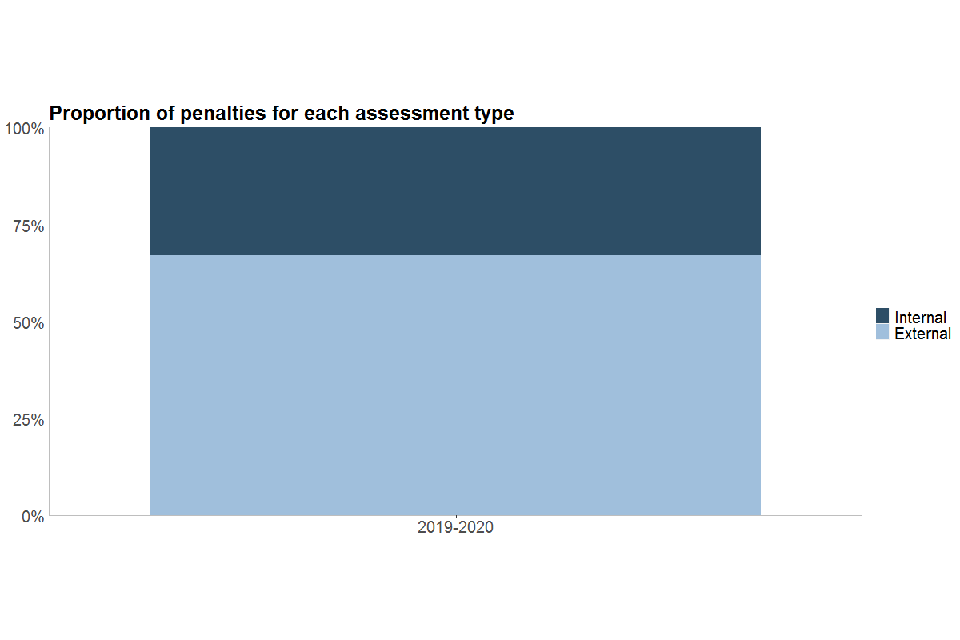
The number of penalties was greater for external assessments with 923 penalties (67% of penalties) compared to internal assessments with 453 penalties (33% of penalties)
Proportion of penalties per assessment method
In 2019 to 2020, the highest number of penalties was issued in paper-based exams, which accounted for 1,005 penalties (73% of penalties). This was followed by online exams with 259 penalties (19% of penalties). The fewest penalties were issued in performance tasks (any task that is not a written/online exam) such as, a presentation or musical performance which had 91 penalties (7% of penalties). This distribution is shown in Figure 4. There were 26 penalties where the assessment methods were documented ‘unknown’ (2% of penalties), which are not shown in the chart.
Figure 4: Proportion of penalties issued for each assessment method

The most penalties were issued in paper-based exams, which accounted for 1,005 penalties (73% of penalties).
Note: Paper-based exams and performance tasks were completed both externally and internally.
Proportion of penalties per assessment schedule
Data was collected to indicate the schedule for external assessments. Figure 5 shows that the majority of penalties issued in external assessments in 2019 to 2020 were for timetabled[footnote 3] assessments and accounted for 493 penalties (36% of penalties). This was followed by on-demand (non-sessional)[footnote 4] assessments and on-demand (sessional)[footnote 5] assessments which accounted for 371 (27% of penalties) and 50 (4% of penalties) penalties respectively. In 2019 to 2020, there were 467 penalties (34% of penalties), where the assessment was either internal or the schedule was unknown. These cases are not shown in the chart.
Figure 5: Proportion of penalties issued for each assessment schedule
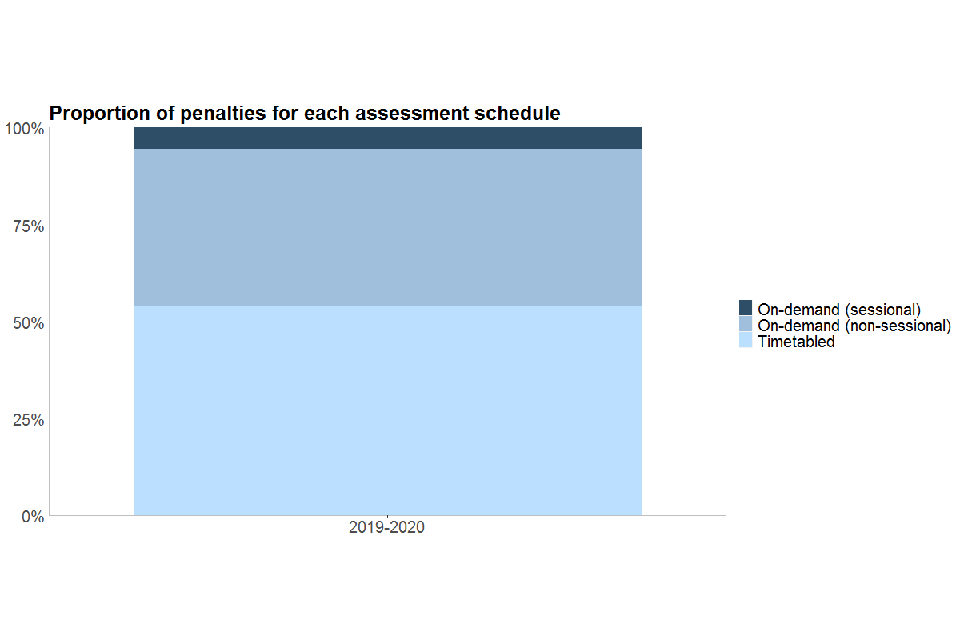
The majority of penalties issued in external assessments in 2019 to 20 were for timetabled assessments and accounted for 493 penalties (36% of penalties).
Penalties per qualification type
In 2019 to 2020, of the 153 qualifications for which malpractice was reported, 91 were PTQs, 53 were FSQs and 9 were Other General qualifications. This translated into a total of 973 penalties issued for PTQs, 346 for FSQs and 45 for Other General qualifications. Note that there were also 17 non-assessment-specific cases that were excluded from this analysis.
Among these qualification types, in 2019 to 2020, PTQs had the largest proportion of penalties relative to their total certifications (0.23%), followed by FSQs with 0.08% of their total certifications and lastly Other General qualifications with 0.03% of their total certifications. Total certifications include all in-scope qualifications for the respective types and academic year (meaning, PTQs in 2019 to 2020, FSQs and Other General qualifications), including those which did not have any reported cases of malpractice. Figure 6 shows this distribution.
Figure 6: Penalties as a percentage of all certificates for each qualification type

PTQs had the largest proportion of penalties relative to their total certifications (0.23%), followed by FSQs with 0.08% of their total certifications and lastly Other General qualifications with 0.03% of their total certifications.
Note: The figures given in the analysis exclude 17 cases of malpractice reported in 2019 to 2020 which were non-assessment-specific malpractice cases, not specific to a single qualification.
Number of penalties per offence
The majority of student, centre and centre staff malpractice cases resulted in one penalty each. Multiple penalties were more common for centres, with fewer than 5 cases resulting in 9 penalties per centre, spread across different cases. The breakdown is shown in Table 1.
Table 1: Number of penalties issued per malpractice case according to malpractice type: student, centre and centre staff member
| Number of penalties | Centre | Centre staff | Student |
|---|---|---|---|
| 1 penalty | 70 | 54 | 1,008 |
| 2 penalties | 8 | 21 | 25 |
| 3 penalties | 0~ | 0~ | 0 |
| 4 penalties | 0 | 0~ | 0~ |
| 5 penalties | 0~ | 0 | 0 |
| 6 penalties | 0~ | 0~ | 0 |
| 7 penalties | 0 | 0 | 0 |
| 8 penalties | 0~ | 0 | 0 |
| 9 penalties | 0~ | 0 | 0 |
Note: There were 68 centre staff penalties and 15 centre penalties excluded from the table as the unique staff and/or centre identifier was unknown. They were included in the rest of the analyses.
Student malpractice
Awarding organisations may impose penalties on students found to have committed malpractice and the type of penalties issued vary depending on the type of offence. An individual student can be penalised more than once and by more than one awarding organisation if they commit malpractice offences for more than one assessment. A student may also receive one penalty for multiple offences.
Type of offence
In 2019 to 2020 a total of 1,074 penalties were issued to students. Figure 7 indicates that the most common type of student malpractice reported in 2019 to 2020 was ‘plagiarism’ and accounted for 35% of all student penalties (381 penalties in 2019 to 2020). The large proportion of malpractice in the form of plagiarism likely reflects the preponderance of internal, coursework-based, assessments in VTQs.
While ‘attempt to influence teachers’ judgements on Centre Assessment Grades and/or rank order’ was added as an additional type of offence for summer 2020 assessments, no penalties were issued for this offence.
Figure 7: Percentage of penalties issued to students for each offence type

The most common type of student malpractice reported in 2019 to 20 was ‘plagiarism’ and accounted for 35% of all student penalties.
Notes:
- ‘Other unauthorised materials’ mentioned in the chart refer to notes, study guides, personal organisers, and personal stereos such as MP3s or iPods.
- ‘Breach of examinations rules and regulations’ mentioned in the chart may refer to, for instance, a student not complying to instructions given by an invigilator, such as continuing to write after being told to stop.
Types of penalty issued
Figure 8 indicates that the most common type of penalty issued to students in 2019 to 2020 was a ‘warning’, accounting for 441 (41%) of the penalties issued, closely followed by a ‘loss of marks’ which accounted for 392 (36%) of the penalties issued.
Figure 8: Number of each type of penalty issued to students
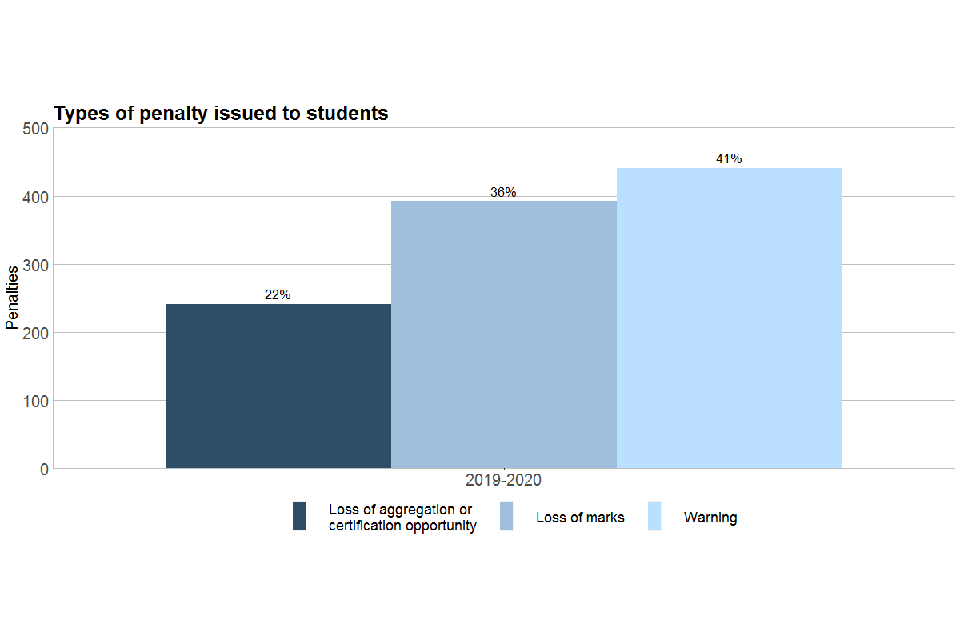
The most common type of penalty issued to students in 2019/20 was a ‘warning’, accounting for 441 (41%) of the penalties issued, closely followed by a ‘loss of marks’ which accounted for 392 (36%) of the penalties issued.
Types of penalty issued to students by type of offence
Penalties for student malpractice varied depending on the type of offence. Figure 9 shows that a ‘loss of marks’ was the most common type of penalty when a student was found with ‘mobile phones or other communication devices’ and a ‘loss of aggregation or certification opportunity’ was most common for ‘collusion’.
Figure 9: Proportion of each type of penalty issued to students for each type of offence
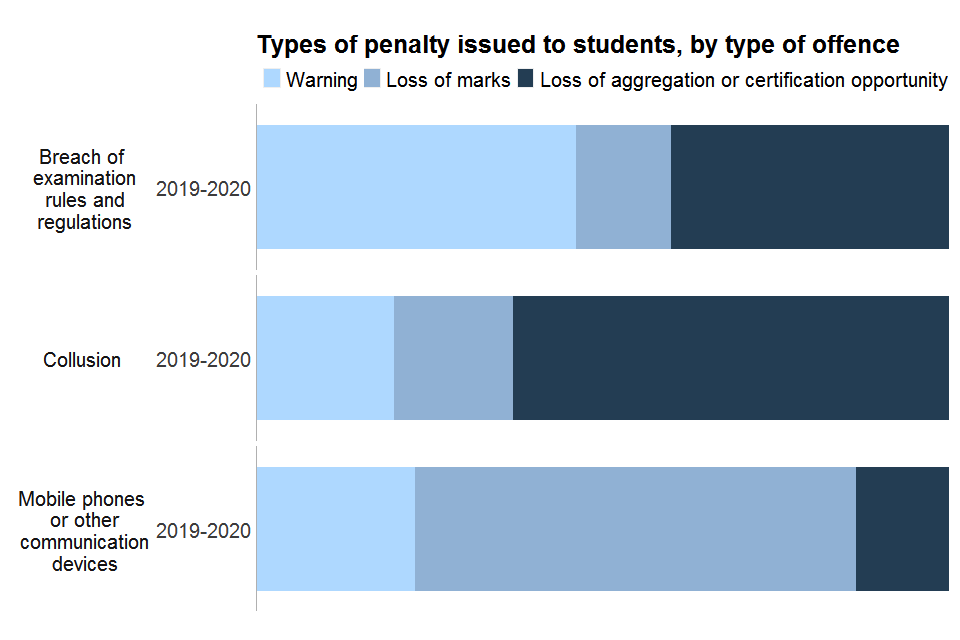
A ‘loss of marks’ was the most common type of penalty when a student was found with ‘mobile phones or other communication devices’ and a ‘loss of aggregation or certification opportunity’ was most common for ‘collusion’.
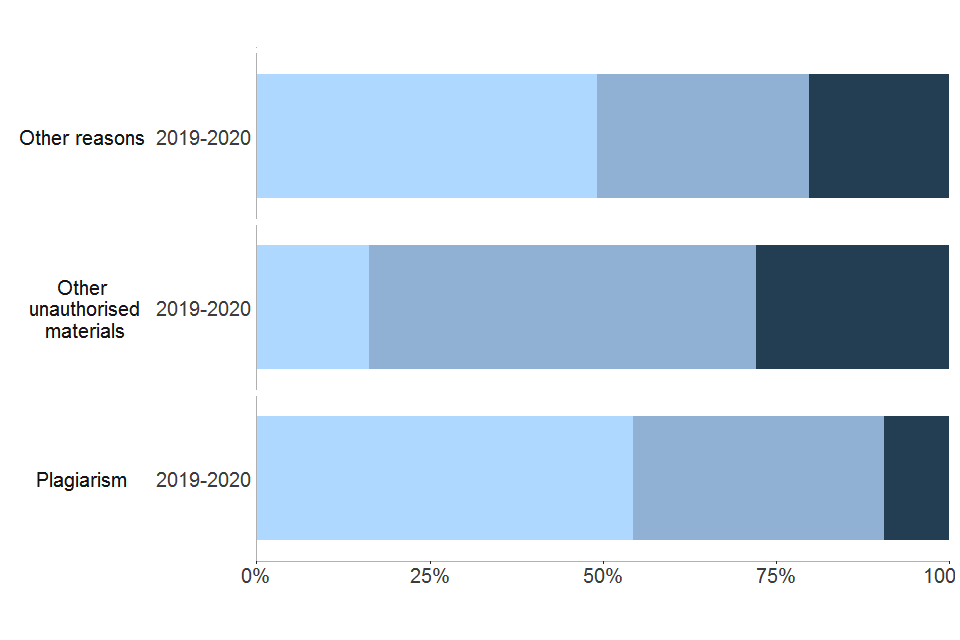
A ‘loss of marks’ was the most common type of penalty when a student was found with ‘mobile phones or other communication devices’.
Staff malpractice
Awarding organisations may impose penalties for malpractice committed by an individual member of staff at a school or college, for example a teacher or an invigilator. More than one penalty can be imposed for a single offence.
Type of offence
In 2019 to 2020 a total of 177 penalties were issued to centre staff. Figure 10 indicates that the most common type of centre staff malpractice reported in 2019 to 2020 was ‘maladministration’ (such as failing to adhere to the regulations regarding the conduct of assessments) with 68 (38%) centre staff penalties. ‘Improper assistance to candidates’ was the second most common staff offence type with 57 (32%) centre staff penalties in 2019 to 2020.
This is where staff provide a candidate or a group of candidates with a potential advantage by giving assistance beyond that which is permitted, such as providing candidates with prompts.
The following 5 categories of malpractice were added specifically for summer 2020:
- bias or discrimination
- centre released CAGs and/or rank orders before the issue of results
- late entry for learners who had not planned to take assessment between 20 March and 31 July 2020
- centre submitted CAGs that do not honestly and fairly represent what learners would have achieved in their assessments
- a failure to accurately report grades of completed units for vocational qualifications
However, no penalties were reported against centre staff for these offences.
Figure 10: Percentage of penalties issued to centre staff for each offence type

The most common type of centre staff malpractice reported in 2019/20 was ‘maladministration’ with 68 (38%) centre staff penalties.
Types of penalty issued
Figure 11 shows that the most common type of penalty issued to centre staff in 2019 to 2020 was a ‘written warning’ and ‘training’, which accounted for 71 (40%) and 70 (40%) centre staff penalties respectively. ‘Training’ refers to specific training or monitoring which is put in place as a condition of future involvement in assessments and is subsequently reviewed.
Figure 11: Number of each type of penalty issued to centre staff
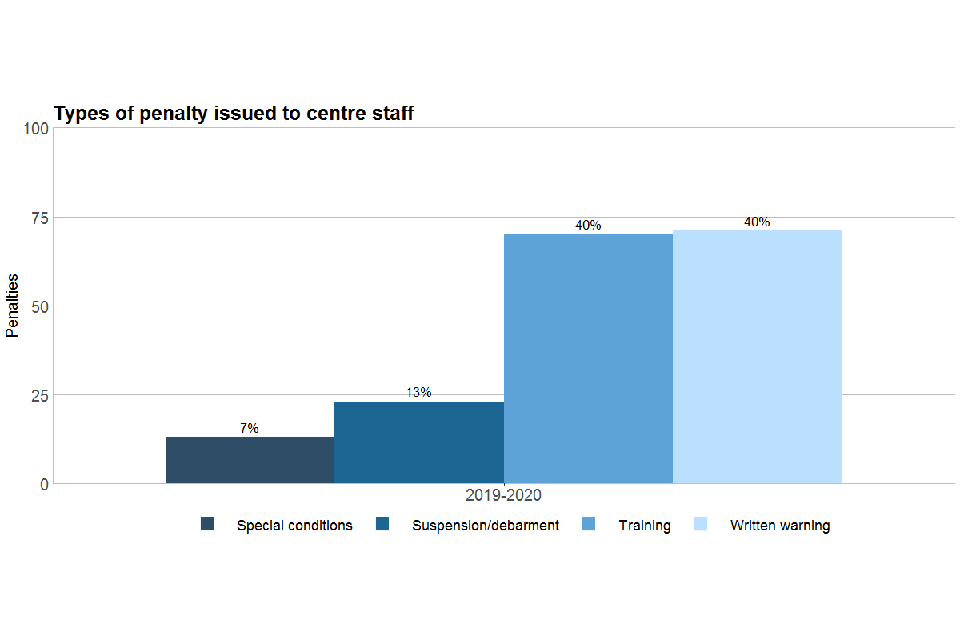
The most common type of penalty issued to centre staff in 2019/20 was a ‘written warning’ and ‘training’, which accounted for 71 (40%) and 70 (40%) centre staff penalties respectively.
Centre malpractice
Where there is evidence that malpractice is the result of a serious management failure, an awarding organisation may apply sanctions against a whole centre.
Type of offence
In 2019 to 2020 a total of 130 penalties were issued to centres. Figure 12 shows that the largest proportion of penalties issued to centres in 2019 to 2020 were for ‘maladministration’, closely followed by ‘improper assistance to candidates’ which accounted for 75 (58%) and 22 (17%) of centre penalties respectively.
The following 5 categories of malpractice were added specifically for summer 2020:
- bias or discrimination
- centre released CAGs and/or rank orders before the issue of results
- late entry for learners who had not planned to take assessment between 20 March and 31 July 2020
- centre submitted CAGs that do not honestly and fairly represent what learners would have achieved in their assessments
- a failure to accurately report grades of completed units for vocational qualifications
Only the offence: ‘centre submitted CAGs that do not honestly and fairly represent what learners would have achieved in their assessments’ had centre penalties reported against it, with fewer than 5 issued. Due to the small number of penalties reported against this offence, it is grouped under ‘other reasons’ in Figure 12.
Figure 12: Percentage of penalties issued to centres for each offence type
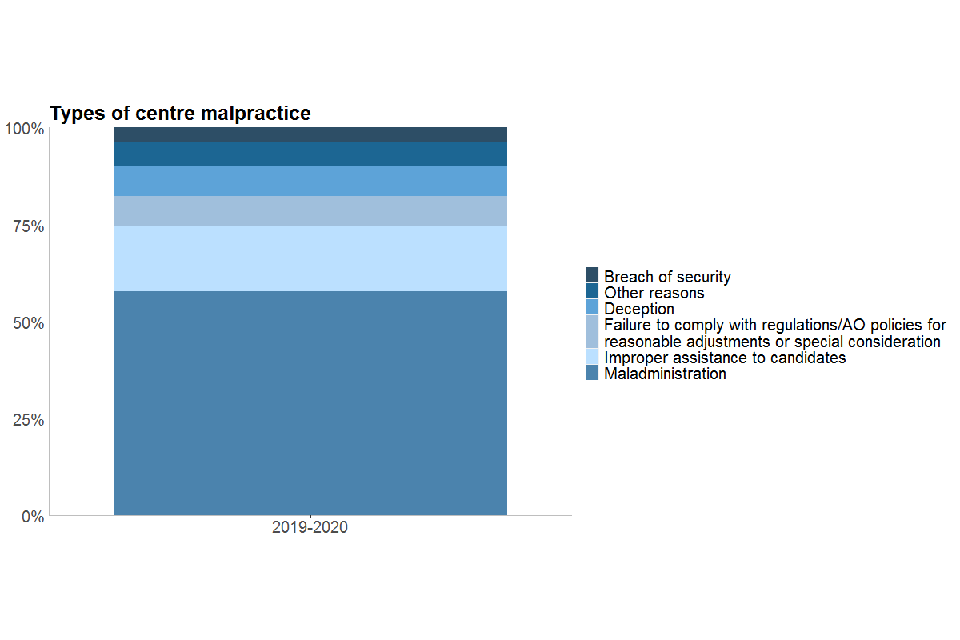
The largest proportion of penalties issued to centres in 2019/20 were for ‘maladministration’, closely followed by ‘improper assistance to candidates’ which accounted for 75 (58%) and 22 (17%) of centre penalties respectively.
Types of penalty issued
Figure 13 shows that the most common type of penalty issued to centres in 2019 to 2020 was ‘withdrawal of approval for a specific qualification’ and ‘written warning’, which accounted for 49 (38%) and 28 (22%) of centre penalties respectively.
Figure 13: Number of each type of penalty issued to centres

The most common type of penalty issued to centres in 2019 to 20 was ‘withdrawal of approval for a specific qualification’ and ‘written warning’, which accounted for 49 (38%) and 28 (22%) of centre penalties respectively.
Examiner malpractice
There were no penalties issued for examiner malpractice in the academic year 2019 to 2020 for the qualifications covered in this report.
-
External assessment is a form of assessment in which question papers, assignments and tasks are specified by the awarding organisation, then taken under specified conditions (including details of supervision and duration) and marking or assessment judgements are made by the awarding. organisation. It does not include moderation or verification of centre-based assessment undertaken by an awarding organisation. ↩
-
Performance based tasks refer to any task that is not a written exam, such as, a presentation or musical performance. ↩
-
Timetabled assessments refer to assessments which can only be taken on specified dates set by Awarding Organisations. ↩
-
On-demand, non-sessional assessments refers to exams that can be taken at any time during the year. ↩
-
On-demand, sessional assessments refer to exams which can be taken at any time within specific windows set by Awarding Organisations. ↩

